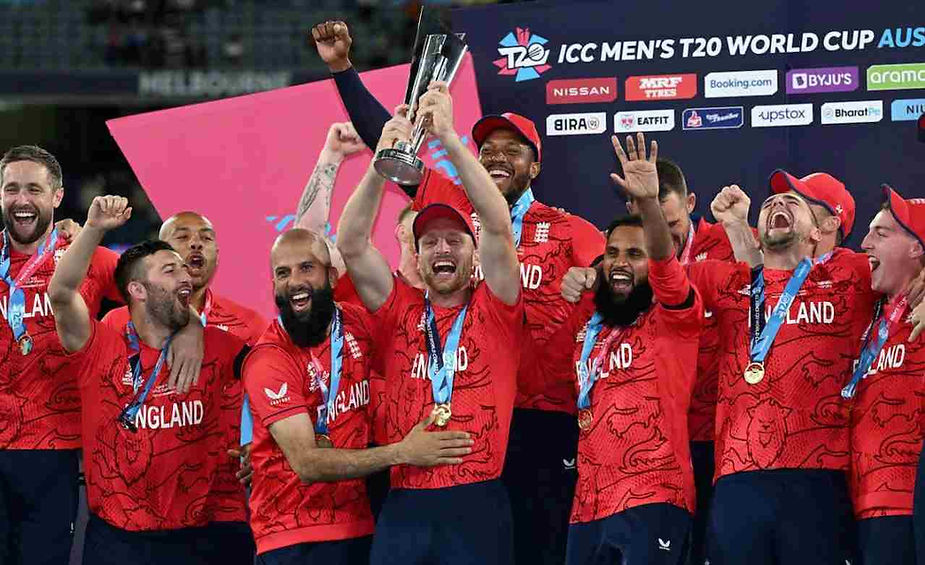ICC Men’s T20 World Cup 2022: England prove their worth again with ‘fearless brand of cricket’ and hard work since Cricket World Cup 2015 debacle. England lift T20 World Cup for the second time.

A total of 16 teams toiled hard in the past 12 months through two Global Qualifier tournaments, out of which the top 4 teams would reach Australia and prove their mettle in the T20 format with the top 12 teams in the ICC Men’s T20 World Cup 2022.
Over the course of four weeks, 28 days, 672 hours, and 45 matches, some teams lost, some won, some cried out of anguish and some saw tears of happiness in their first victory. While some teams outperformed big teams on the biggest stage and others simply crumbled under pressure, out of all the teams, one came out victorious, smashing opponents, picking wickets when needed, and never letting the momentum take hold. One such team was none other than the current and new two-time T20 world champions England!
What has changed for England since 2015?
England fans and supporters were subjected to brutal agony at the Adelaide Oval in 2015, when they lost to Bangladesh and were knocked out of the Cricket World Cup 2015. It was the then England captain, Eoin Morgan, who decided to shape this England side for good. Morgan’s approach and mental model were very clear: he wanted to build a team that could go all guns blazing no matter who the opponent was, no matter what the playing conditions were and no matter what the occasion was – a T20 World Cup, a 50-over World Cup or business as usual in bilateral series.
The mental model that plays a role is always brushed under the carpet. But the former England captain and the England coaching staff ensured that the carpet was always with them. Ben Stokes wasn’t discarded since the 2016 World Cup final loss to the West Indies. Instead, he was groomed to be the key player who eventually became instrumental in getting England two World Cup titles, one in each limited overs format. If it was just any other team, they would have benched the potential and calibre of Stokes, but Eoin had different plans.
Captain Morgan had a vision like no other. He, along with the team’s management, coaches and support staff, started at the grassroots level. They created a pool of 15 players in the team and a surplus of 15 backups who could come into the squad any day without blinking an eye through great performances in the T20 Vitality Blast, where they had given specific roles to players.
Imagine a team winning the World Cup without their premier bowlers, Jofra Archer and Mark Wood. India missed out on the services of Jasprit Bumrah who sustained a crippling back injury before the World Cup, and as a result India looked like a different team altogether in the big event. Pakistan looked like a different team altogether in the final at the Melbourne Cricket Ground (MCG) when their lead pacer Shaheen Shah Afridi had to move out from the ground after getting injured taking a catch. The global T20 superstars looked like different teams, and one cannot even imagine Australia or New Zealand without Mitchell Starc/Pat Cummins or Trent Boult/Tim Southee, respectively. But that has always been the case with England’s talent pool.
Read More: T20 WC 2022: Another final and Ben Stokes eases into the job without surprise

Jos the boss: Covered all the bases
It’s one thing to create a legacy, and it’s another to continue it. And boy, oh boy! Jos Buttler carried on Eoin Morgan’s momentum and elegantly led England to the pinnacle through their fearless brand of cricket. In cricket’s 100-plus years, there has not been a single team that has been able to say that all 11 of its players can bat, and boy, can they bat. England’s No. 11 Adil Rashid has a first-class century to his name.
Since 2016, England have played 27 series across the T20 format, including three T20 World Cups. Out of that, England have won 15 series (including the 2022 T20 World Cup) with a series win ratio of 56 per cent. Decoding how England have been so successful with their fearless brand of cricket leads to only one thing: Depth!
Be it batting, bowling, or fielding, England’s depth has been nothing short of magic. Eight out of their 11 players can bowl; 11 out of their 11 players can bat; and 100 pc of their players can throw themselves on the field in order to save a boundary or attempt a seemingly impossible catch. Unlike teams like India, Sri Lanka, South Africa, Pakistan and Bangladesh, where they have third man and fine leg positions reserved in order to hide their weak fielders, England were the only participants in this World Cup with backups for every position and possibly every batting or bowling character.
Ben Stokes could cover any day if Chris Woakes wasn’t able to swing the ball. When the accurate death stage bowler and yorker specialist, Mark Wood, is injured, Chris Jordan can fill in. Moeen Ali can take the ball away from the left-handed batters, while Adil Rashid can weave a leg-spin web for the right-handed batters, and if both fail, the golden arm of Liam Livingstone can just break crucial partnerships whenever needed. Dawid Malan doesn’t fire, Stokes steps up and plays the sheet anchor role. Jonny Bairstow gets injured, Alex Hales wears the dancing shoes, and life turns into the opening slot.
It was as if England had been writing this script for ages. England had answers to everything that was thrown at them. To top it off and test the waters with their players, their management even arranged a T20 series right where the World Cup was being played five days later.
Read More: T20 WC 2022, Final, ENG v PAK: Curran’s 3-12, Stokes’ 52* help England avenge 1992 loss in Melbourne

Go all out or go home? The T20 success mantra?
It goes without saying that many teams will now try to replicate what England did and try playing their brand of cricket. It would be preferable if hitting the first ball wasn’t as easy as it appears. We have seen it with teams across the globe.
Teams like India, Australia and New Zealand have tried this approach and have failed miserably. The champs of the bilateral series, India, have been practising this brand of cricket on Asian pitches and in bilateral series, but when it comes to pressure situations, India end up throwing in the towel. India’s very first match of T20 World Cup 2022 against Pakistan, or in the match against England, saw early setbacks, and the blue T20 jersey was switched to the conservation test jersey in an attempt to save wickets.
But in England, the approach has been consistent. No matter if one wicket, two wickets, or four fall in a row, the new batter coming in would try to smash the fifth ball if it’s in his zone. Even in the match against Pakistan, when Naseem Shah bowled four straight outswingers to Jos Buttler with the team two wickets down, Buttler didn’t look to take a single and rotate. He just punched the ball towards covers for a counterattacking boundary, which then put Shah on the back foot. Players like Dawid Malan and Ben Stokes were given roles to take the game deep and they did play safe when the chips were down with nothing on the board. The rest of the lot were given the licence, and not just any other licence, but a jet craft licence to smash the leather of the cricket ball.
Rotating strikes, a conservative approach and taking it deep are so 90s, to say the least, when it comes to England, and credit must go to their team management and the captain, as many coaches have changed in the recent past but the approach remained the same: just go for the kill. It would be interesting to see who would be the next team to go with this approach and actually be consistent with it even when the turn of events is not in their favour!
Read More: India need a new brand of cricket in T20Is post disappointing Semi-Final exit in T20 World Cup 2022

